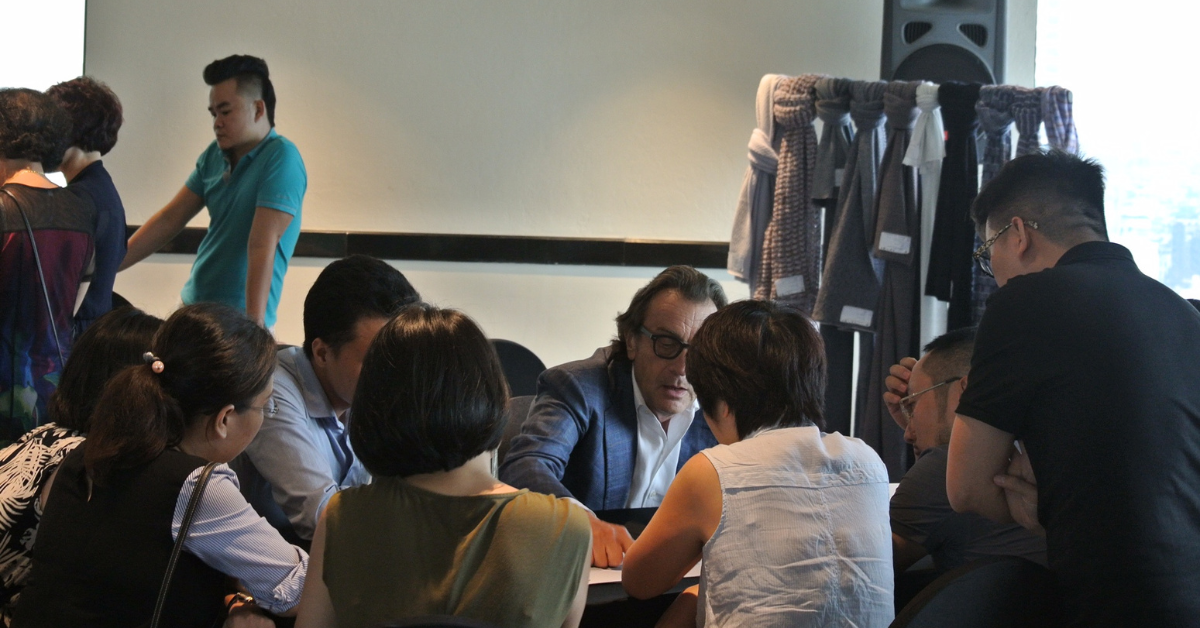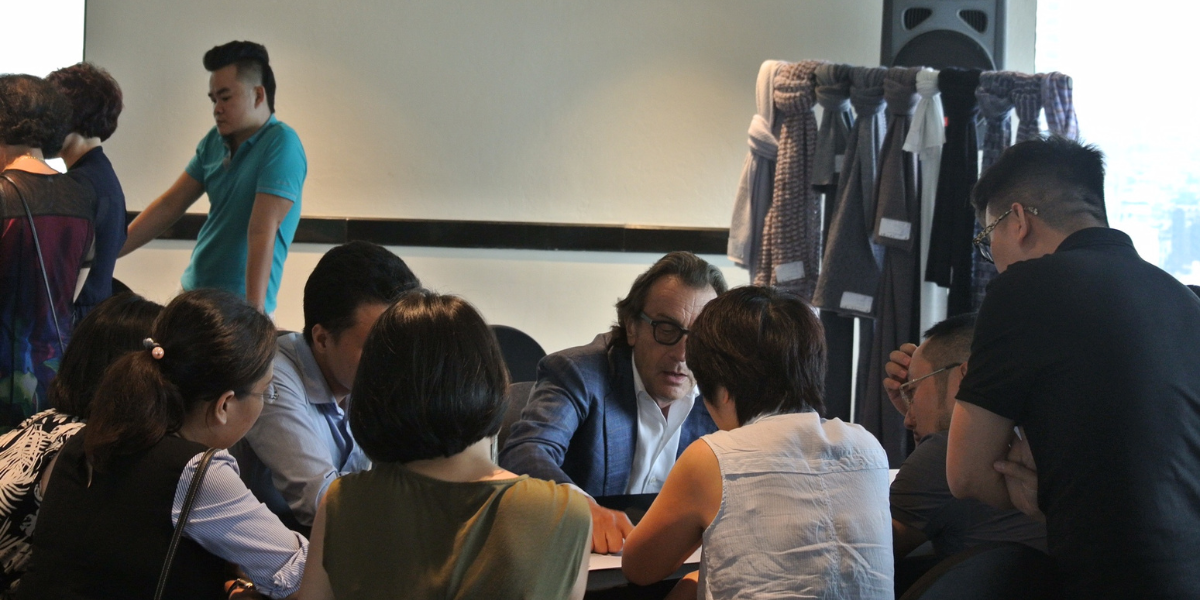Anna Lottersberger, Dean of Ferrari Fashion School, recently interviewed Luciano Bandi, Lecturer of the Master of Arts in Fashion and Luxury Management. Their discussion explored Bandi’s extensive journey in the luxury textile industry, focusing on key topics such as maintaining material quality, implementing sustainability in supply chains, and the importance of vertical integration. They also addressed how luxury brands can balance innovation with traditional craftsmanship and shared effective marketing strategies, along with valuable advice for aspiring managers in the luxury fashion sector.
Luciano Bandi is a textile industry professional whose career began in 1978 as a product manager at Filatura di Grignasco. In 1983, he moved to Loro Piana, where he contributed to the establishment of a division for cashmere yarns. He concluded his career as the commercial director and a member of the Board of Directors at Zegna Baruffa Lane Borgosesia, also dedicating himself to training the new generations in the sector.
Can you share a bit about your journey in the luxury textile industry and your different roles during your career? How did it all started?
I began my collaboration with Loro Piana in 1983. In those years it was just a well-known manufacturer for the production of high quality fabrics, produced with the most precious fibers becoming one of the most important supplier for the world of luxury, because the promotion of the Loro Piana brand for the finished products just began at the beginning of the new century. Since the 60s of last century Loro Piana was the supplier of the luxury market and the “haute couture” that was completely different from today. The clothes were of a sober elegance, where value was given to the garment by quality and comfort.
The luxury fashion market is supposedly known for its emphasis on material quality and innovation. How do brands ensure that these values are maintained throughout the supply chain?
Today it is very important not to confuse the real lux with the brand. Often automatically if a brand is very well known or very expensive, it is automatically referred to as luxury product. The luxury product is made of quality, experience, research and specialization. Innovation is key to achieving the best efficiency, but it must respect the basics of luxury. Brands can be sure to maintain very high-quality standards only if they check the supply chain, identifying high-level suppliers and not seeking maximum profit by looking for suppliers with more competitive prices. Maintaining long-term relationships with the same suppliers is the first and most important guarantee of quality. Sustainability has become a key concern in the luxury industry.


Sustainability has become a key concern in the luxury industry. How do luxury companies implement sustainable practices into their supply chain, from sourcing raw materials to final production?
Today we talk a lot about sustainability but it has many faces. The starting point is to preserve the planet through a production cycle that respects very precise rules to minimize pollution. The starting point is to define what product to make. Green design is the basis of a whole production cycle, starting from the raw material, to go through the less aggressive chemical products, until the moment when the product will be abandoned because it can no longer be used. To be sure that all elements of the supply chain are organised towards the greatest possible sustainability, two things are important. The continuity of the relationship with its suppliers as seen above and research. This will help identify the best opportunities the market can offer.
Can you discuss the importance of vertical integration in the luxury textile supply chain? How do companies leverage this strategy to maintain control over quality and production?
Another element that ensures the control of the supply chain is verticalization. The companies that really do luxury have been and continue to be the first to seek a verticalization to control and innovate their supply chain. Often the suppliers of these brands are small companies but with a great capacity and experience. The fact that the brand acquires them means to guarantee a very important technical capacity, but also to insert new financial resources to innovate and enhance their efficiency.

Innovation is crucial in staying competitive in the luxury market. How can luxury brands balance innovation and technology with the need to preserve traditional craftsmanship and heritage?
Today there is a lot of talk about innovation but we have missed a term that was fundamental in the craft: specialization. Innovating without maintaining specialization means losing one’s identity and quality. Loro Piana in the early 1980s had “industrialized” with cutting-edge innovations, the production of cashmere. Cashmere was the company’s specialty,so it innovated in specialisation. Before arriving at the final result, many research were done together with textile machine manufacturers in order to maintain that “artisanal” quality but in an industrial product. This has made the Loro Piana extremely efficient, but above all effective in responding to a market demand that required more quantities and competitive prices. This could be an example of a combination between quality and innovation where experience and specialization have also made it possible to improve the performances of that product. In this case cashmere. The Tasmanian, for example, had the same basic motivation: knowledge of raw materials, production systems and very forward-looking technological research.
Raw materials are considered an ingredient for fashion. What kind of marketing strategies textile companies have to communicate the value of their research and quality to end users?
For those who produce a fabric or yarn and have no direct contact with the market, It becomes more difficult to make the final consumer understand what are the uniqueness of their product, both in terms of raw material quality and particular characteristics of the product that make it different from other similar alternatives. It is therefore important that those who buy these products, make the user understand the importance and particularities of the materials used. Once the end consumer has understood that a fabric or yarn made by a particular manufacturer has excellent performances, it is the same user who asks the garment makers to use that particular material. Of course, labels that confirm that the yarn or fabric has actually been purchased by the manufacturer requested by the final consumer, make it an indispensable vehicle for information. The fact that Loro Piana gave labels that certified its fabrics and were placed inside the clothes produced by various garment makers made the company known to the final consumer and helped increase market demand forcing those who do not wanted to buy Loro Piana fabrics, to do so if he wanted to keep the clients. The same was for the labels that Zegna Baruffa delivers to distinguish its yarn quality and confirming that are strictly made in Italy.

How do you foster a culture of excellence and innovation within your team, with stakeholders and clients?
I think that first of all we need to create a product culture in all the people involved in the production process. It is necessary to make all the employees understand that only through a product and a production organisation on the highest quality can you achieve excellence. Everyone must understand that only by working in teams can you succeed. If you achieve excellence, you can easily achieve market leadership. To achieve that goal you must have the courage to make choices, to specialize in a certain type of product and work to continuously improve your efficiency and efficacy . This can only happen if we create a corporate culture, a willingness to train people to understand and, through research and innovation, in advance the demands of a market in constant evolution. When you reach leadership you have to work much more because everyone will try to take your place. When you have a leadership based on quality, customers automatically demand you and at that moment you have a “temporary monopoly” of the market, which also allows for better margins. It is your job to keep it as long as possible this position.
What advice would you give to aspiring managers who wish to make a mark in the luxury fashion industry, particularly in textiles?
I don’t think there are any specific formulas to become a reference in the luxury market. As for any market level, you have to have passion for the product on which you work. Without passion you don’t go far. I also think that the curiosity in seeing everything around us and not just our scope, is a source of continuous inspiration and allows us to understand if any strategies, considered unusable on what we believe working, be adaptable to our needs, giving us the opportunity to be a leader and not a follower. Our goal, from the moment we think a goal (product or marketing strategy) must be to achieve leadership. If we think in this way we will certainly be led to work differently from our competitors, to look for a quality that distinguishes us, to make ourselves known for the quality of the product and not because we have a financial capacity to advertise our product. The advertising passes, the product quality remains in the consumer mind. We remember how comfortable it was when we wore it, how versatile it could be because it can be used in different situations, how respectful it was of the environment because, even after years, it could be used by reducing significantly the waste that today’s fast fashion – and not only – leads us to do. We must have the strength to create an identifiable product. Often the people try to create a brand and the product is more based on image. True luxury is made of substance not image. If the substance “creates” the image the brand is timeless.


Looking ahead, what trends or shifts do you believe will shape the future of luxury fashion and its supply chain?
The luxury market is obviously reserved for a relatively small market, but enough to make many brands coexist. The paths to leadership positions are relatively few. There are, in my view, two macro-realities in the luxury market. What at Loro Piana was called “understatement” and today, is often referred to as “quiet luxury” or a market that likes to show its social position through a very showy way of dressing. This depends on the personal culture but also and much more on the geographical culture. When we talk about “quiet luxury” we are talking about a consumer who has a fairly thorough knowledge of the product he is going to buy and consequently chooses that specific brand because it is synonymous of quality and seriousness. The second consumer is more image-oriented. There is less interest in quality, where and how it was produced. I think the consumer of a more exhibited luxury needs some time to understand that to be “elegant” you must have the courage to appear unnoticed and be appreciated by all those who understand luxury in its intrinsic essence. This essence is made of quality, knowledge of how and where the product is made, understanding that high prices are the result of an high quality made of selected raw material, the respect of high skill and experience of the workers, the investments in respecting the environments and not just going in search of the best price to obtain the maximum profit. If behind every luxury brand could be crearted a school of “arts and crafts”, the ability to make a product (and not only textile) of the highest quality, will never end. I think these are the reasons on which luxury must be based, while taking into account the cultural diversity of the consumers to whom it is directed, without losing sight of its own essence made up of seriousness, professionalism and respect for the workers and the environment.
Thank you, Luciano, for sharing your valuable insights with us. We look forward to seeing you in class for more discussions on luxury fashion.







